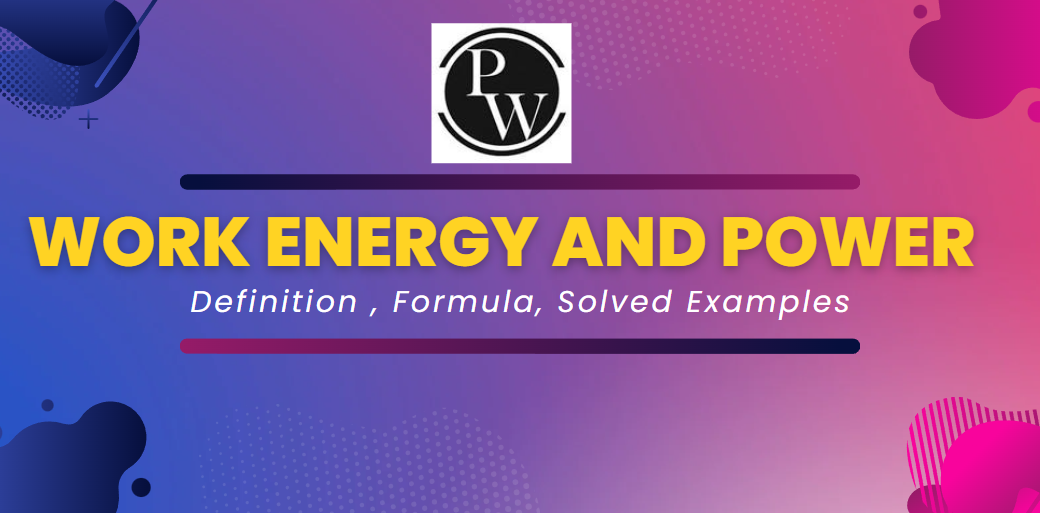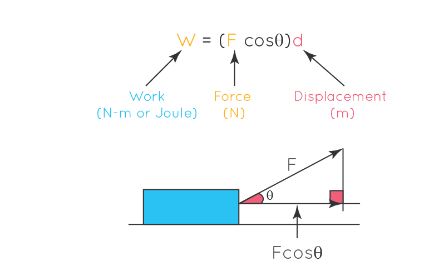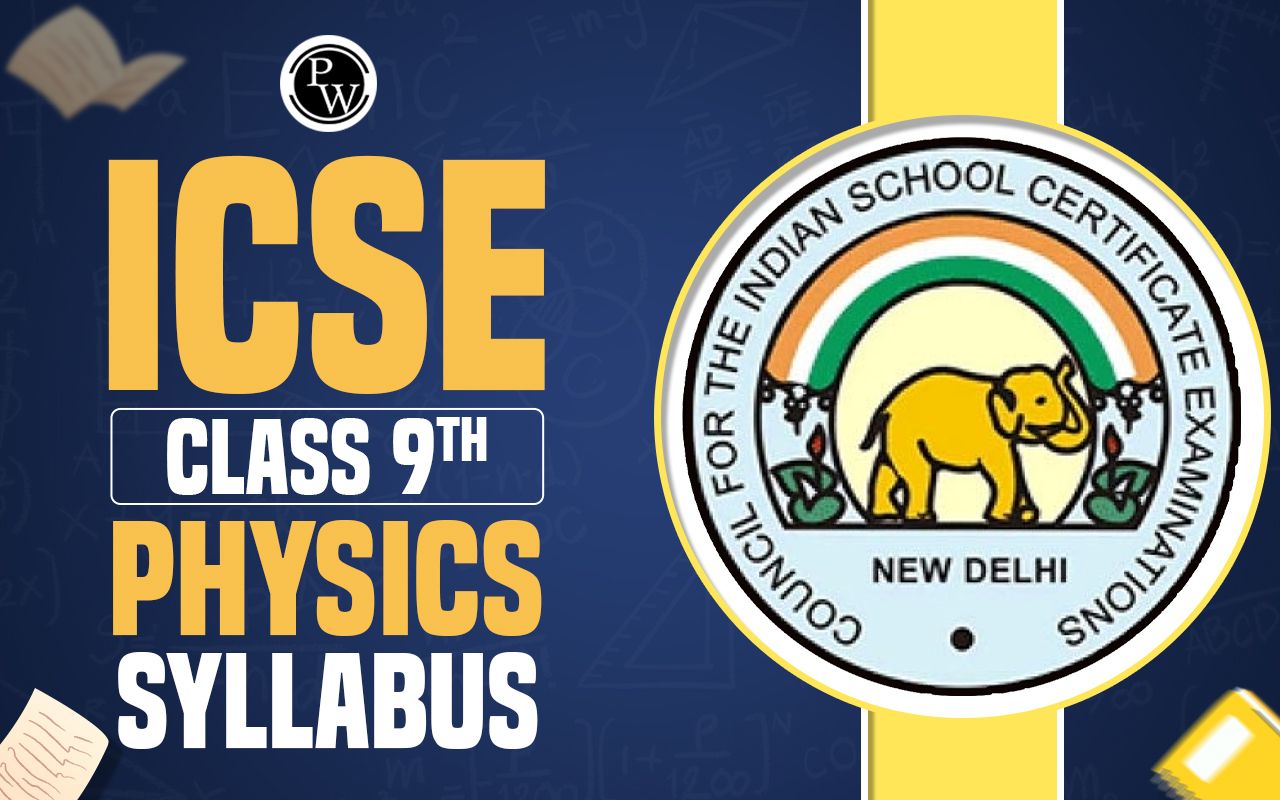

Work energy and power formula are fundamental concepts in physics that help us understand and describe the motion and interactions of objects in the physical world. They are crucial in various scientific and engineering applications and are interconnected in various ways.
What is Work?
When an object is subjected to a force and is propelled over a distance in the direction of the force, work is defined in the context of physics as the transfer of energy from one system to another. In simpler terms, work is done when a force causes a displacement. Work is a scalar quantity and is measured in joules (J) in the International System of Units (SI). The formula for calculating work is: : Work (W) = Force (F) × Displacement (d) × cos(θ) Where:- W is the work done,
- F is the magnitude of the force applied,
- d is the displacement of the object, and
- θ is the angle between the force and the displacement vectors.

Example:
Lifting a box from the ground to a shelf. When you apply a force to lift the box, you do work on it by transferring energy, increasing its potential energy as it moves upward. Also Check - Unit, Dimension and Vector FormulaWhat is Energy?
In Work Energy Power ,Energy is a fundamental idea in physics that represents a system's ability to produce heat or do work. It can be found in many different forms, including kinetic energy, potential energy, thermal energy, electrical energy, and others. The SI unit of energy is the joule (J).Example:
an amusement ride at the summit of a hill. It now possesses the highest possible potential energy and the lowest possible kinetic energy. Potential energy changes into kinetic energy as it makes its way down the slope, giving it speed and excitement.Download PDF Work Energy and Power Formula
Types of Energy
Energy can exist in various forms, and each type of energy has specific formulas to quantify its magnitude or calculate its effects. Here are some common types of energy and their corresponding formulas: 1.Understanding the energy involved in an object's motion requires the use of the kinetic energy formula. The following is the kinetic energy equation: K.E. = 1/2 (m v 2 ) In this equation, KE represents the kinetic energy of the object. The symbol “m” refers to the mass of the object, while “v” represents its velocity.\Also Check - Heat Transfer Formula
2.Potential Energy (PE): The potential energy of an object depends on its position relative to a reference point and is stored energy. PE = m g h where: PE = Potential Energy m = mass of the object g = acceleration due to gravity. 3.Gravitational Potential Energy: The equation for gravitational potential energy is: GPE = m⋅g⋅h Where, m is the mass in kilograms g is the acceleration due to gravity (9.8 on earth) h is the height above the ground in metres 4.Thermal Energy: The thermal energy of an object is related to its temperature and depends on its specific heat capacity. Q = m c ΔT where: Q = Thermal Energy m = mass of the object c = specific heat capacity of the material ΔT = change in temperature 5.Electrical Energy: E = V Q where: E = Electrical Energy ,V = voltage or potential difference Q = electric charge 6.Chemical Energy: The chemical energy in a substance is related to its chemical composition and can be released through chemical reactions. Formula: It varies depending on the specific chemical reaction or process. 7.Nuclear Energy: The energy released during nuclear reactions, such as nuclear fission or fusion, involves the conversion of mass into energy according to Einstein's famous equation. E = Δmc 2 where: E = Energy released m = mass lost during the reaction c = speed of light.What is Power?
In Work Energy Power,Power is the speed at which work is completed or energy is moved or transformed. It gauges how rapidly energy is produced or utilised. Power is a scalar quantity and is measured in watts (W) in the SI system. The formula for calculating power is: Power (P) = Work (W) / Time (t) Where:- P is the power,
- W is the work done, and
- t is the time taken to do the work.
Work Energy and Power FAQs
What is work?
The product of the force acting on an object and the distance it travels under the influence of that force is known as work. Work (W) can be calculated mathematically using the formula: W = Fdcos(), where F denotes force, d denotes displacement, and denotes the angle between the force and displacement vectors.
What is conservation of energy?
According to the conservation of energy principle, energy cannot be generated or destroyed; it can only be transformed from one form to another. The total energy in a closed system is constant.
What is power?
Power (P) is the rate at which work is done or the rate at which energy is transferred or transformed. It is calculated as: P = W / t, where W is the work done and t is the time taken.
How does friction affect work and energy?
Friction opposes motion and can result in energy loss, portion of the mechanical energy is converted to thermal energy. This can affect the efficiency of systems and the amount of useful work done.
🔥 Trending Blogs
Talk to a counsellorHave doubts? Our support team will be happy to assist you!

Free Learning Resources
PW Books
Notes (Class 10-12)
PW Study Materials
Notes (Class 6-9)
Ncert Solutions
Govt Exams
Class 6th to 12th Online Courses
Govt Job Exams Courses
UPSC Coaching
Defence Exam Coaching
Gate Exam Coaching
Other Exams
Know about Physics Wallah
Physics Wallah is an Indian edtech platform that provides accessible & comprehensive learning experiences to students from Class 6th to postgraduate level. We also provide extensive NCERT solutions, sample paper, NEET, JEE Mains, BITSAT previous year papers & more such resources to students. Physics Wallah also caters to over 3.5 million registered students and over 78 lakh+ Youtube subscribers with 4.8 rating on its app.
We Stand Out because
We provide students with intensive courses with India’s qualified & experienced faculties & mentors. PW strives to make the learning experience comprehensive and accessible for students of all sections of society. We believe in empowering every single student who couldn't dream of a good career in engineering and medical field earlier.
Our Key Focus Areas
Physics Wallah's main focus is to make the learning experience as economical as possible for all students. With our affordable courses like Lakshya, Udaan and Arjuna and many others, we have been able to provide a platform for lakhs of aspirants. From providing Chemistry, Maths, Physics formula to giving e-books of eminent authors like RD Sharma, RS Aggarwal and Lakhmir Singh, PW focuses on every single student's need for preparation.
What Makes Us Different
Physics Wallah strives to develop a comprehensive pedagogical structure for students, where they get a state-of-the-art learning experience with study material and resources. Apart from catering students preparing for JEE Mains and NEET, PW also provides study material for each state board like Uttar Pradesh, Bihar, and others
Copyright © 2025 Physicswallah Limited All rights reserved.











